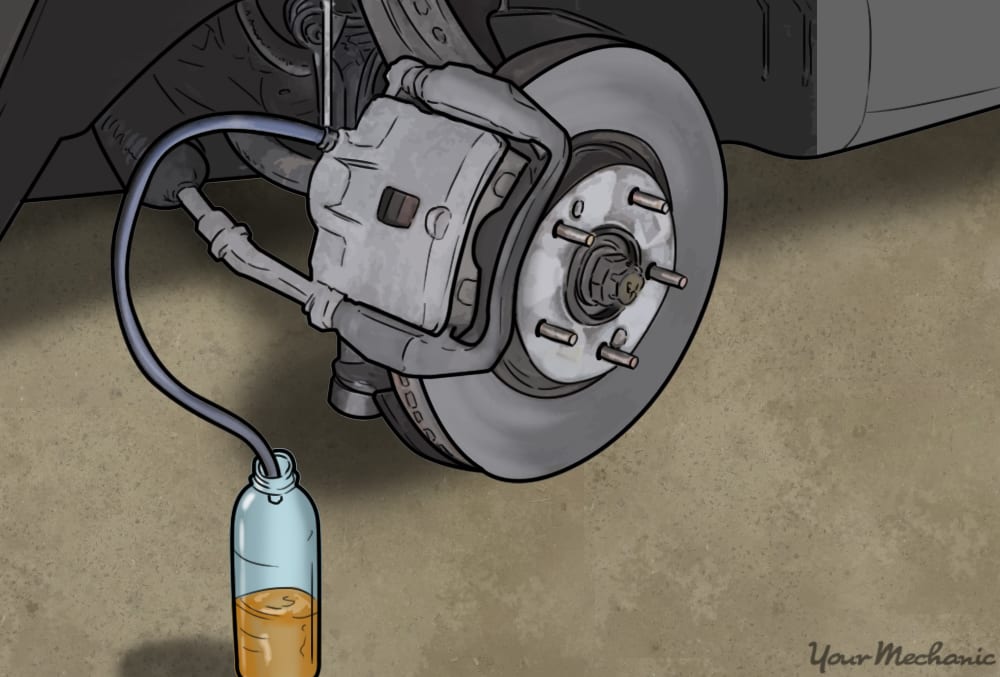

Maintaining your car’s brake system is hugely important to vehicle safety. Brake fluid helps transfer the pressure from a driver’s foot to the brake pedal to stop the vehicle. Its levels must remain full and in good condition. Low fluid levels or fluid in poor condition will not let the brakes help you stop the car. Brakes are usually serviced by a mechanic, but sometimes you need to bleed brakes to remove trapped air and flush out old or contaminated fluid. This means you’ll also need to return the brake fluid reservoir to acceptable levels — most designs include a “min” and “max” line for reference.
You’ll want to be extra careful when handling new or old brake fluid. It is alcohol-based and highly flammable. It is not toxic on its own but quickly becomes so when contaminated. While sitting in a car, it absorbs heavy metals that make it poisonous when ingested by humans or animals. Even new, uncontaminated brake fluid left in a jar that’s been opened tends to absorb enough water to dangerously reduce its boiling point, further increasing its flammability. It should never be poured down the sink, storm drain, into a septic tank, or onto the ground.
Unused brake fluid may be left behind in a container opened for refilling fluid levels. Old brake fluid removed from a car counts as hazardous waste and needs to be taken to a treatment facility. Small spills and amounts left in new bottles can be taken care of at home. Whether dealing with fresh or tainted brake fluid, know how to properly dispose of it after use.
Brake Fluid Disposal at Home
Smaller amounts of brake fluid don’t always warrant the trip to an automotive shop or waste treatment center. If you have kitty litter, a bucket or pan of some sort, and a sealable garbage bag, brake fluid can be absorbed, evaporated, and thrown away in 3 easy steps:
Pour brake fluid into a pan of clean kitty litter. Fill a large, flat-bottomed bowl or tray, or a metal pan you’d use for catching car fluids, with about a half-inch of kitty litter. Then, pour the brake fluid over the kitty litter, or, when draining old fluid from the car, have the bowl set up to collect it.
Leave the pan uncovered and let it sit for 3-4 days. Make sure the pan is left somewhere away from pets or children due to toxicity, and far from sources of heat or flame because of flammability. It will be absorbed by the kitty litter and, since it is alcohol-based, it will evaporate over the course of a few days.
Throw out the litter once all the fluid evaporates. After a few days, shake the tray to check for leftover fluid, and let it sit longer if any remains. Once it’s completely dry, pour the litter into a plastic garbage bag, seal the top, and toss it out with the rest of your trash.
Recycling Brake Fluid
Like many automotive fluids, brake fluid can be recycled. It must be taken to a recycling center, where it is typically mixed with suitable liquids to create alternative fuels for other purposes. Follow these 5 steps for proper storage and recycling-transportation of brake fluid:
Seal brake fluid in a jar. Prepare it for transportation to a recycling center by putting it in a container with a secure lid.
Find a waste recycling center nearby. Use online or other resources to find recycling centers that accept brake fluid. Earth911, for example, lets you plug in your zip code to see the places closest to your location.
Check for free collection events. While they’ll accept your brake fluid at regular hours for a fee, some recycling centers offer free collection days. Such information is usually listed on a company website or can be found out through a phone call.
Check nearby auto parts stores if there aren’t any close recycling centers. Many auto shops will recycle brake fluid that hasn’t been mixed with other car liquids.
Transport the brake fluid. Bring the fluid to the recycling center or auto body shop. Be aware that some places require a special container. If so, you’ll want to pick up the container before attempting to drop off the fluid.
Disposing of Brake Fluid at a Waste Management Facility
Similar to finding a recycling facility, a waste treatment facility will safely treat and dispose of your contaminated brake fluid. However, in this method, you’ll want to make sure the waste center will accept hazardous waste. Find and deliver the brake fluid to the appropriate facility in 3 steps:
Research local waste facilities nearby. Use online other resources to find a waste disposal site. Many localities offer public ones run by the local government.
Make sure the center accepts hazardous waste. Garauntee your local disposal site will accept old brake fluid. Some places may not be equipped to take in something deemed hazardous.
Transport the brake fluid. Seal old brake fluid in a secure jar or plastic container to prevent spillage and take it to your chosen waste disposal site. Very few places will offer to pick-up hazardous waste, so be prepared to deliver it yourself and pay a small fee. Some facilities may offer free drop-off and request a donation, financial or otherwise, instead.



